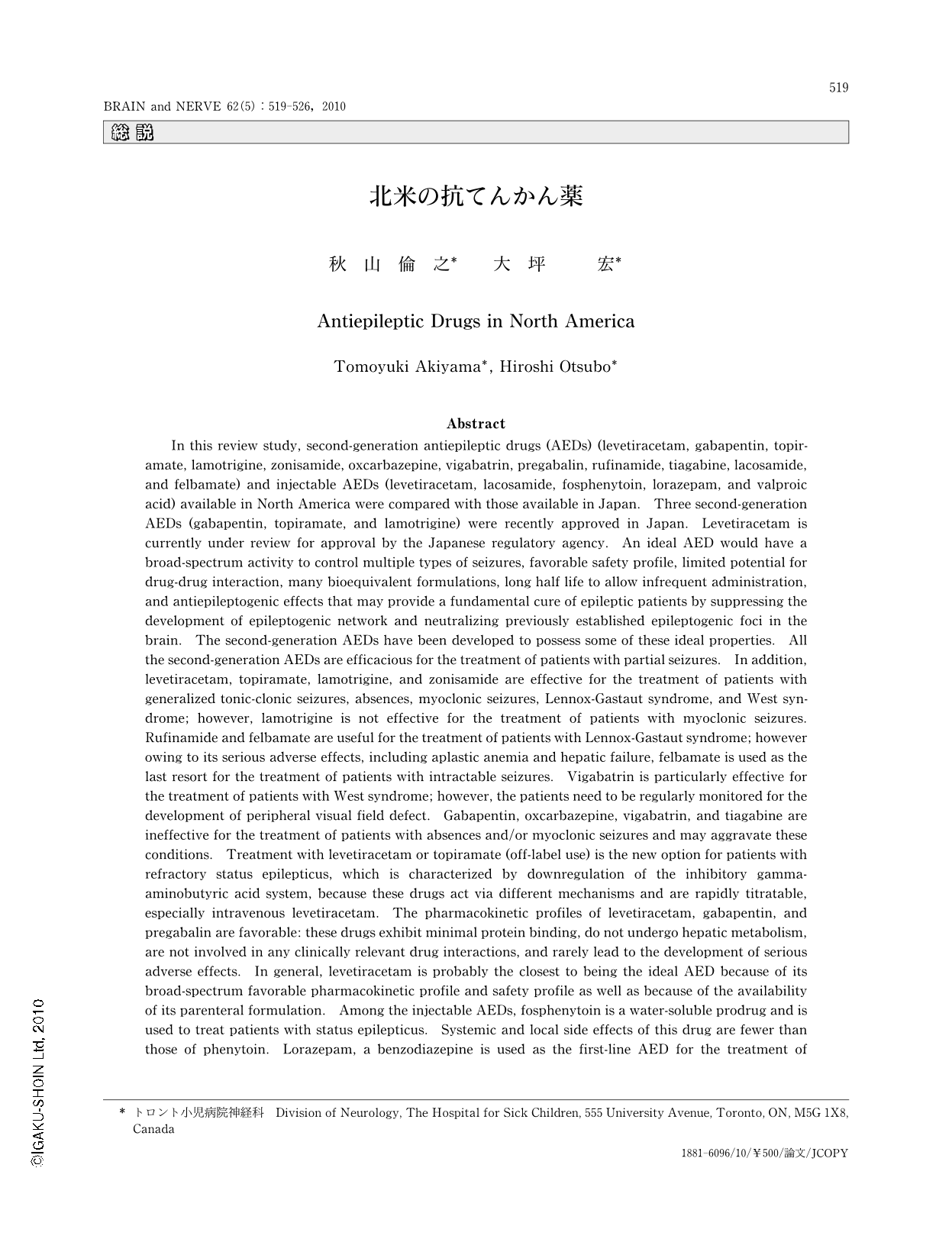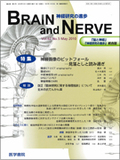Japanese
English
- 有料閲覧
- Abstract 文献概要
- 1ページ目 Look Inside
- 参考文献 Reference
はじめに
1993年以降,米国では新しい抗てんかん薬が12種類承認されており,カナダでも5種類(special access drugを含め8種類)が使用できる。日本では,2006年に至るまで,これらの薬剤(ゾニサミド以外)を使うことができなかった。ガバペンチン,トピラマート,ラモトリギンがようやく承認されたが,これらは北米のほか,ヨーロッパやアジア諸国でも既に広く使われている。日本における抗てんかん薬の整備は,まだまだ大幅に遅れていると言わざるを得ない。
理想的な抗てんかん薬とは何か? 多種類のてんかん発作型に有効で,副作用が少なく,他剤との相互作用がなく,半減期が長く,かつ抗てんかん原性を有するものである。抗てんかん原性とは,脳内の異常なてんかんネットワークの発展を抑え,既存のてんかん焦点を中和し,てんかんを根本的に治癒させる能力である1)。現時点での抗てんかん薬は,新薬も含め,抗てんかん発作薬であり,患者が成長し自然に発作を起こさなくなるまで症状を緩和・抑制する対症療法としての薬剤である1)。
最近承認された新しい抗てんかん薬は,第2世代抗てんかん薬と呼ばれている。従来の薬剤に比し,理想的な抗てんかん薬に近い特性を備えるべく開発された薬剤である。
本稿では,執筆時点(2009年10月)での北米における承認内容と実態に基づき,北米で使用されている第2世代抗てんかん薬および日本で未承認の注射薬について概説する。
Abstract
In this review study, second-generation antiepileptic drugs (AEDs) (levetiracetam, gabapentin, topiramate, lamotrigine, zonisamide, oxcarbazepine, vigabatrin, pregabalin, rufinamide, tiagabine, lacosamide, and felbamate) and injectable AEDs (levetiracetam, lacosamide, fosphenytoin, lorazepam, and valproic acid) available in North America were compared with those available in Japan. Three second-generation AEDs (gabapentin, topiramate, and lamotrigine) were recently approved in Japan. Levetiracetam is currently under review for approval by the Japanese regulatory agency. An ideal AED would have a broad-spectrum activity to control multiple types of seizures, favorable safety profile, limited potential for drug-drug interaction, many bioequivalent formulations, long half life to allow infrequent administration, and antiepileptogenic effects that may provide a fundamental cure of epileptic patients by suppressing the development of epileptogenic network and neutralizing previously established epileptogenic foci in the brain. The second-generation AEDs have been developed to possess some of these ideal properties. All the second-generation AEDs are efficacious for the treatment of patients with partial seizures. In addition, levetiracetam, topiramate, lamotrigine, and zonisamide are effective for the treatment of patients with generalized tonic-clonic seizures, absences, myoclonic seizures, Lennox-Gastaut syndrome, and West syndrome; however, lamotrigine is not effective for the treatment of patients with myoclonic seizures. Rufinamide and felbamate are useful for the treatment of patients with Lennox-Gastaut syndrome; however owing to its serious adverse effects, including aplastic anemia and hepatic failure, felbamate is used as the last resort for the treatment of patients with intractable seizures. Vigabatrin is particularly effective for the treatment of patients with West syndrome; however, the patients need to be regularly monitored for the development of peripheral visual field defect. Gabapentin, oxcarbazepine, vigabatrin, and tiagabine are ineffective for the treatment of patients with absences and/or myoclonic seizures and may aggravate these conditions. Treatment with levetiracetam or topiramate (off-label use) is the new option for patients with refractory status epilepticus, which is characterized by downregulation of the inhibitory gamma-aminobutyric acid system, because these drugs act via different mechanisms and are rapidly titratable, especially intravenous levetiracetam. The pharmacokinetic profiles of levetiracetam, gabapentin, and pregabalin are favorable: these drugs exhibit minimal protein binding, do not undergo hepatic metabolism, are not involved in any clinically relevant drug interactions, and rarely lead to the development of serious adverse effects. In general, levetiracetam is probably the closest to being the ideal AED because of its broad-spectrum favorable pharmacokinetic profile and safety profile as well as because of the availability of its parenteral formulation. Among the injectable AEDs, fosphenytoin is a water-soluble prodrug and is used to treat patients with status epilepticus. Systemic and local side effects of this drug are fewer than those of phenytoin. Lorazepam, a benzodiazepine is used as the first-line AED for the treatment of patients with status epilepticus. The effects of this drug are more prolonged than those of diazepam. Intravenous administration of valproic acid is regarded as a new treatment option for patients with status epilepticus, because sedative and negative effects on the cardiorespiratory system of this drug are lesser than those of the traditional injectable AEDs. These novel medications will aid the improvement of the quality of life of epileptic patients through improved seizure control and reduced adverse effects.
(Received: November 12,2009,Accepted: February 22,2010)

Copyright © 2010, Igaku-Shoin Ltd. All rights reserved.


